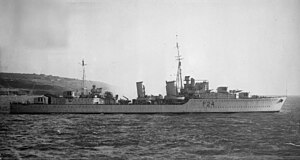HMS Maori (F24)
 Maori underway
| |
| History | |
|---|---|
| Name | Maori |
| Namesake | Māori people |
| Ordered | 10 March 1936 |
| Builder | Fairfield Shipbuilding and Engineering Company, Govan |
| Cost | £340,622 |
| Laid down | 6 July 1936 |
| Launched | 2 September 1937 |
| Completed | 30 November 1938 |
| Commissioned | 5 December 1938 |
| Identification | Pennant numbers: L24/F24/G24 |
| Fate | Sunk by aircraft, 12 February 1942 |
| General characteristics (as built) | |
| Class and type | Tribal-class destroyer |
| Displacement |
|
| Length | 377 ft (114.9 m) (o/a) |
| Beam | 36 ft 6 in (11.13 m) |
| Draught | 11 ft 3 in (3.43 m) |
| Installed power |
|
| Propulsion | 2 × shafts; 2 × geared steam turbines |
| Speed | 36 knots (67 km/h; 41 mph) |
| Range | 5,700 nmi (10,600 km; 6,600 mi) at 15 knots (28 km/h; 17 mph) |
| Complement | 190 |
| Sensors and processing systems | ASDIC |
| Armament |
|
HMS Maori was a Tribal-class destroyer named after the indigenous Māori people of New Zealand. She served with the United Kingdom Mediterranean Fleet during World War II until she was bombed and sunk by German aircraft while at Malta in 1942. Her wreck was later raised and scuttled outside the Grand Harbour. The wreck is now a dive site.
Description
The Tribals were intended to counter the large destroyers being built abroad and to improve the firepower of the existing destroyer
The primary armament of the Tribal-class destroyers was eight
The ships were fitted with a single above-water quadruple mount for
Wartime modifications
Heavy losses to German air attack during the
Construction and career
Authorized as one of seven Tribal-class destroyers under the 1935 Naval Estimates,
Maori joined
In May 1941, she participated in the pursuit and destruction of the German battleship Bismarck. While escorting Convoy WS-8B to the Middle East, Maori, along with the destroyers Cossack, Sikh and Zulu broke off on 26 May and headed towards the area where Bismarck had been reported. They found her that evening and made several torpedo attacks in the evening and into the next morning. No hits were scored but they kept her gunners from getting any sleep, making it easier for the battleships to attack her the next morning. Maori then rescued some of the survivors from Bismarck after the battleship sank.[19]

She served with the 14th Destroyer Flotilla during the Battle of Cape Bon in December 1941.[20] Maori, commanded by Commander R. E. Courage, RN, was attacked by German aircraft and sunk at her moorings in the Malta Grand Harbour on 12 February 1942, with the loss of one of her crew; she was raised and scuttled off Fort Saint Elmo on 15 July 1945.
Wreck

Notes
- ^ Lenton, p. 164
- ^ English, p. 14
- ^ a b Lenton, p. 165
- ^ a b English, p. 12
- ^ March, p. 322
- ^ a b Whitley, p. 99
- ^ Hodges, pp. 13–25
- ^ Friedman, p. 32
- ^ Hodges, pp. 30–31, 40
- ^ English, p. 15
- ^ Friedman, p. 34; Hodges, pp. 41–42
- ^ Whitley, p. 116
- ^ Brice, p. 11
- ^ Colledge & Warlow, p. 215
- ^ English, p. 16
- ^ The Times (London), 3 September 1937, p. 6
- ^ Brice, p. 157; English, pp. 13, 16
- ^ "HMS Maori". Subway Dive Centre. Archived from the original on 11 October 2014. Retrieved 2 September 2014.
- ^ The Times (London), 28 May 1941, p. 4
- ^ The Times (London), 15 December 1941, p. 3
References
- Birchfield, B.; Borgenstam, Carl; Caruana, Joseph & Frampton, Viktor (1988). "Question 3/87". Warship International. XXV (2): 205–210. ISSN 0043-0374.
- Brice, Martin H. (1971). The Tribals. London: Ian Allan. ISBN 0-7110-0245-2.
- English, John (2001). Afridi to Nizam: British Fleet Destroyers 1937–43. Gravesend, Kent: World Ship Society. ISBN 0-905617-64-9.
- ISBN 1-86176-137-6.
- Haarr, Geirr H. (2010). The Battle for Norway: April–June 1940. Annapolis, Maryland: Naval Institute Press. ISBN 978-1-59114-051-1.
- Haarr, Geirr H. (2009). The German Invasion of Norway, April 1940. Annapolis, Maryland: Naval Institute Press. ISBN 978-1-59114-310-9.
- Hodges, Peter (1971). Tribal Class Destroyers. London: Almark. ISBN 0-85524-047-4.
- ISBN 1-55750-048-7.
- ISBN 1-59114-119-2.
- ISBN 0-87021-326-1.
